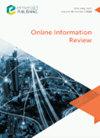通过不同的传播媒介说服他人:诉诸逻辑、权威和情感
IF 3.1
3区 管理学
Q2 COMPUTER SCIENCE, INFORMATION SYSTEMS
引用次数: 0
摘要
目的长期以来,研究说服问题的学者们对逻辑、情感和权威--逻各斯(logos)、道德(ethos)和病态(pathos)--的诉求进行了区分,但为解释现场面对面对话过程而提出的观点也必须在新媒体中进行测试。我们的目的是测试这三种策略在通过不同通信媒体进行一对一聊天时的有效性。我们采用 3 × 3 × 2 主体间因子设计,在通过三种通信媒体(面对面、Skype 视频或 Skype 文本)进行的一对一聊天(女性-女性或男性-男性对)中测试了这三种策略。说服情景改编自之前的研究,在这些研究中,学生们被要求将综合考试作为学位的一部分。研究结果表明,女性与女性、男性与男性之间的差异微乎其微。徽标吸引力在说服受试者改变其态度方面总体效果最佳。此外,与其他两种诉求条件相比,在徽标诉求条件下,受试者对自己观点的解释与说服脚本最为相似。另外,在基于文本的聊天条件下,受试者对悲怆劝说表示了一定程度的不赞同,但这似乎并没有对实际态度的改变产生影响。研究局限/启示我们研究的一个主要局限是我们的受试者是大学生,因此不能代表一般的互联网用户。未来的研究应该在不同背景的人群中测试这三类说服策略。实践意义虽然我们的样本量足以进行统计检验,但由于时间、人员和经费的限制,我们的样本量仍然相对较小。社会意义我们的研究结果表明,在用户可能没有足够的领域知识或没有意识到需要识别或检查给定信息的情况下,使用事实核查工具来打击虚假信息是有帮助的。此外,与纠正信息相比,消除虚假信息传播的影响可能需要付出更多的努力,因为有些用户可能不仅会相信虚假信息,而且可能会开始以与虚假信息中类似的方式进行推理。 原创性/价值以往有关网络说服的研究仅对一对一说服过程中传播媒体和说服策略是否以及如何相互作用进行了有限的研究。我们的实验尝试通过研究三种不同传播媒体和三种不同说服策略下的说服过程和结果来弥补这一不足。本文章由计算机程序翻译,如有差异,请以英文原文为准。
Persuading others in different communication media: appeals to logic, authority and emotion
PurposeScholars of persuasion have long made a distinction between appeals to logic, emotion and authority- logos, ethos and pathos- but ideas developed to account for live face-to-face conversation processes must also be tested in new media. We aimed to test the effectiveness of these three strategies in one-to-one chats through different communication media.Design/methodology/approachWith a 3 × 3 × 2 between-subject factorial design, we tested these three strategies in one-to-one chats (female–female or male–male pairs) through three communication media: face-to-face, Skype video or Skype text. The persuasion scenario was adapted from prior studies in which students were presented with the idea of requiring a comprehensive exam as part of their degree. The participants were all undergraduate students of a major university in USA.FindingsOur results showed trivial differences between female–female and male–male conditions. The logos appeal worked best overall in persuading the participants to change their reported attitudes. Additionally, the explanations provided by the participants for their own opinions were most like the persuasion scripts in the logos condition compared to the other two appeal conditions. Separately, participants indicated some disapproval of the pathos appeal in the text-based chat condition, although this did not seem to make a difference in terms of actual attitude change.Research limitations/implicationsOne major limitation of our study is that our subjects are college students and therefore are not representative of Internet users in general. Future research should test these three types of persuasion strategies on people of diverse backgrounds. For example, while logos seems to be most effective strategy in persuading college students (at least in our study), pathos or ethos may be more effective when one attempts to persuade people of different backgrounds.Practical implicationsAlthough it is enough for a statistical test, our sample size is still relatively small due to constraints on time, personnel and funding. We also recognize that it is challenging both conceptually and empirically to compare the effectiveness of three persuasion strategies separately.Social implicationsOur findings suggest it is helpful to use fact-checking tools to combat disinformation in cases where users may not have sufficient domain knowledge or may not realize the need to identify or examine the given information. Additionally, it may require more effort to negate the impact of the disinformation spread than correcting the information, as some users may not only believe false information but also may start to reason in ways similar to those presented in the disinformation messages.Originality/valuePast studies on online persuasion have limitedly examined whether and how communication media and persuasion strategies interact in one-to-one persuasion sessions. Our experiment makes an attempt to close this gap by examining the persuasion process and outcome in three different communication media and with three different persuasion strategies.
求助全文
通过发布文献求助,成功后即可免费获取论文全文。
去求助
来源期刊

Online Information Review
工程技术-计算机:信息系统
CiteScore
6.90
自引率
16.10%
发文量
67
审稿时长
6 months
期刊介绍:
The journal provides a multi-disciplinary forum for scholars from a range of fields, including information studies/iSchools, data studies, internet studies, media and communication studies and information systems.
Publishes research on the social, political and ethical aspects of emergent digital information practices and platforms, and welcomes submissions that draw upon critical and socio-technical perspectives in order to address these developments.
Welcomes empirical, conceptual and methodological contributions on any topics relevant to the broad field of digital information and communication, however we are particularly interested in receiving submissions that address emerging issues around the below topics.
Coverage includes (but is not limited to):
•Online communities, social networking and social media, including online political communication; crowdsourcing; positive computing and wellbeing.
•The social drivers and implications of emerging data practices, including open data; big data; data journeys and flows; and research data management.
•Digital transformations including organisations’ use of information technologies (e.g. Internet of Things and digitisation of user experience) to improve economic and social welfare, health and wellbeing, and protect the environment.
•Developments in digital scholarship and the production and use of scholarly content.
•Online and digital research methods, including their ethical aspects.
 求助内容:
求助内容: 应助结果提醒方式:
应助结果提醒方式:


